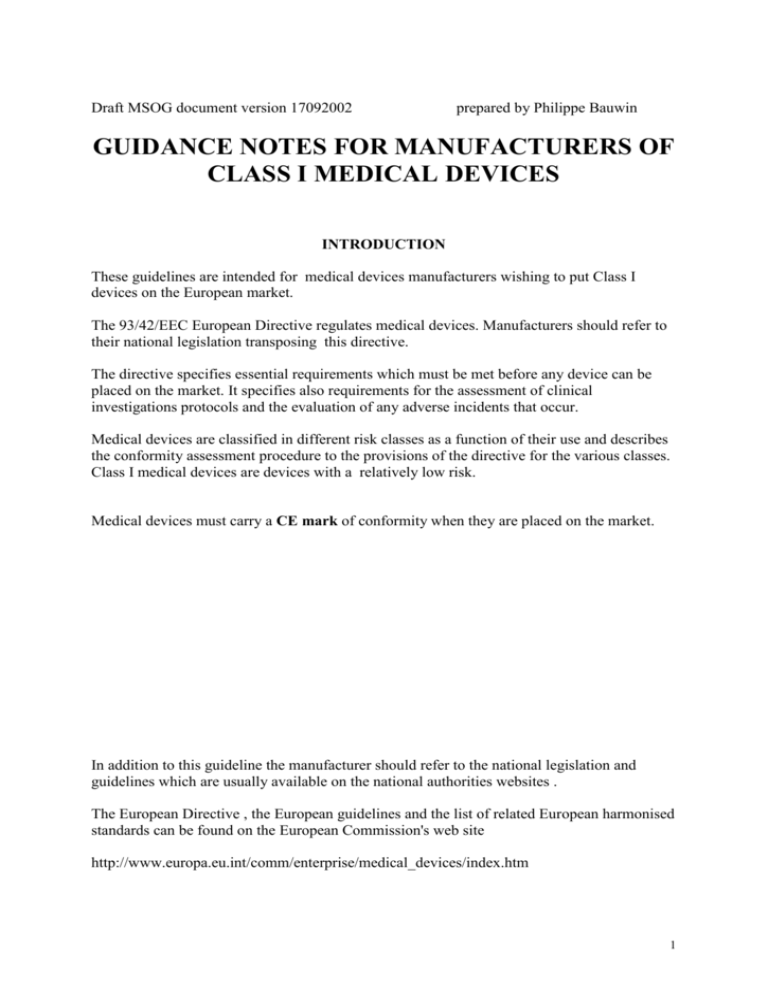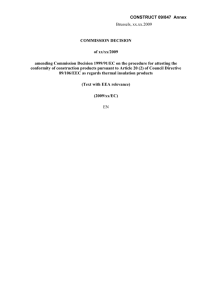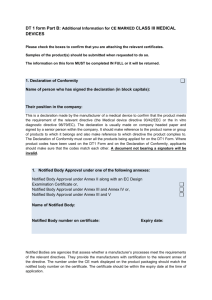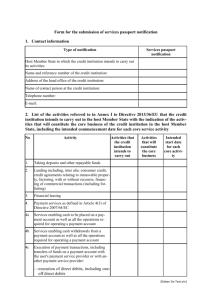examples of class i medical devices
advertisement

Draft MSOG document version 17092002
prepared by Philippe Bauwin
GUIDANCE NOTES FOR MANUFACTURERS OF
CLASS I MEDICAL DEVICES
INTRODUCTION
These guidelines are intended for medical devices manufacturers wishing to put Class I
devices on the European market.
The 93/42/EEC European Directive regulates medical devices. Manufacturers should refer to
their national legislation transposing this directive.
The directive specifies essential requirements which must be met before any device can be
placed on the market. It specifies also requirements for the assessment of clinical
investigations protocols and the evaluation of any adverse incidents that occur.
Medical devices are classified in different risk classes as a function of their use and describes
the conformity assessment procedure to the provisions of the directive for the various classes.
Class I medical devices are devices with a relatively low risk.
Medical devices must carry a CE mark of conformity when they are placed on the market.
In addition to this guideline the manufacturer should refer to the national legislation and
guidelines which are usually available on the national authorities websites .
The European Directive , the European guidelines and the list of related European harmonised
standards can be found on the European Commission's web site
http://www.europa.eu.int/comm/enterprise/medical_devices/index.htm
1
STEPS TO BE FOLLOWED
1) VERIFY IF YOUR PRODUCT IS A MEDICAL DEVICE AND IF IT IS CLASS I
'medical device' means any instrument, apparatus, appliance, material or other article, whether used alone or in
combination, including the software necessary for its proper application intended by the manufacturer to be used
for human beings for the purpose of:
- diagnosis, prevention, monitoring, treatment or alleviation of disease,
- diagnosis, monitoring, treatment, alleviation of or compensation for an injury or handicap,
- investigation, replacement or modification of the anatomy or of a physiological process,
- control of conception,
and which does not achieve its principal intended action in or on the human body by pharmacological,
immunological or metabolic means, but which may be assisted in its function by such means;
In Appendix A you will find examples of Class I medical devices.
You will find in Appendix B examples of products which are not medical devices but
individual protection devices , cosmetic products or other
Classification rules can be found in Annex IX of the Directive .
The Guideline : classification of medical devices Meddev 2.4/1 gives additional guidance and
many examples
The Guidelines Meddev 2.1/3 and 2.1/4 explain the demarcation with other European
Directives
If you have still doubts contact your National Competent Authority
2) IF YOUR PRODUCT IS A MEDICAL DEVICE AND OF CLASS I FOLLOW THE
REQUESTED CONFORMITY ASSESMENT PROCEDURE
Article 11 point 5 of the Directive says:
In the case of devices falling within Class I, other than devices which are custom-made or
intended for clinical investigations, the manufacturer shall, in order to affix the CE marking,
follow the procedure referred to in Annex VII and draw up the EC declaration of conformity
required before placing the device on the market.
What this means will be explained below
Remark:
Don’t forget to take in account art 1 point 5 of the directive that lists the type of products to
which the Directive does not apply (for example devices incorporating stable human blood
derivatives that are submitted to an other directive) and the special classification rules under
point 4 annex IX.
For example , rule 13 says: all devices incorporating , as an integral part, a substance which if
used separately , can be considered to be a medicinal product , as defined in article 1 of
Directive 65/65/EEC , and which is liable to act on the human body with action ancillary to
that of the devices , are in class III.
Rule 17 classifies most devices manufactured utilizing animal tissues or derivatives in class
III
2
3) BEFORE PUTTING THE PRODUCT ON THE MARKET NOTIFY YOUR NATIONAL
COMPETENT AUTHORITY
.
Article 14 of the Directive says:
Registration of persons responsible for placing devices on the market
1. Any manufacturer who, under his own name, places Class I devices on the market in
accordance with the procedures referred to in Article 11 (5) ……………………shall
inform the competent authorities of the Member State in which he has his registered place
of business of the address of the registered place of business and the description of the
devices concerned.
If your place of business is outside the Member States follow this procedure
2. Where a manufacturer who places devices referred to in paragraph 1 on the market under
his own name does not have a registered place of business in a Member State, he shall
designate the person(s) responsible for marketing them who is (are) established in the
Community. These persons shall inform the competent authorities of the Member State in
which they have their registered place of business of the address of the registered place of
business and the category of devices concerned.
Refer to your national authority for the notification process in your country.
REMARK:
It is important to realize that this notification is not a simple formality. Before notifying the
manufacturer shall perform all activities needed to ensure that the product is safe and
performs as requested and prepare a technical documentation that must allow assessment of
the conformity of the product with the requirements of the directive. This documentation
shall be made available on request to the competent authorities. Then he will make a
declaration of conformity that specifies that the product concerned meets the provisions of the
Directive that applies to it. Only then has he the right to apply the CE mark on the product and
notify the national authority. There are post-marketing obligations such as the notification of
incidents . Authorities are responsible for market surveillance and in this context will monitor
the activities of their Class I manufacturers.
3
CONFORMITY ASSESMENT PROCEDURE
ACCORDING ANNEX VII OF THE DIRECTIVE
1) THE TECHNICAL DOCUMENTATION
1.1 GENERAL INFORMATION:
The manufacturer must prepare the technical documentation described below. The
manufacturer or his authorized representative established in the Community must make this
documentation , including the declaration of conformity, available to the national authorities
for inspection purposes for a period ending at least five years after the last product has been
manufactured.
The technical documentation must allow assessment of the conformity of the products with
the requirements of the directive.
The devices must meet the essential requirements set out in Annex I of the Directive which
apply to them, taking in account of the intended purpose of the devices concerned.
The documentation must include in particular:
-
a general description of the product, including any variants planned,
- design drawings, methods of manufacture envisaged and diagrams of components, subassemblies, circuits, etc.,
- the descriptions and explanations necessary to understand the abovementioned drawings
and diagrams and the operations of the product,
- the results of the risk analysis and a list of the standards referred to in Article 5 of the
Directive, applied in full or in part, and descriptions of the solutions adopted to meet the
essential requirements of the Directive if the standards referred to in Article 5 have not
been applied in full,
- in the case of products placed on the market in a sterile condition, description of the
methods used,
- the results of the design calculations and of the inspections carried out, etc.; if the device
is to be connected to other device(s) in order to operate as intended, proof must be
provided that it conforms to the essential requirements when connected to any such
device(s) having the characteristics specified by the manufacturer,
- the test reports and, where appropriate, clinical data in accordance with Annex X,
- the label and instructions for use.
Member States shall presume compliance with the essential requirements in respect of devices which are in
conformity with the relevant national standards adopted pursuant to the harmonized standards the references of
which have been published in the Official Journal of the European Communities; Member States shall publish
the references of such national standards.
Reference to harmonized standards also includes the monographs of the European Pharmacopoeia notably on
surgical sutures and on interaction between medicinal products and materials used in devices containing such
medicinal products, the references of which have been published in the Official Journal of the European
Communities.
4
1.2 DETAILED INFORMATION ON THE NORMAL CONTENT OF THE TECHNICAL
DOCUMENTATION
Examples are given of what the documentation would normally include. These are not
exhaustive and each case has to be examined individually. Data available from the literature ,
from component suppliers or preliminary documented clinical experience can in some cases
be used. Depending on the type of product some tests will not be required. This can be
determined by a proper risk analysis.
The description of the product:
A general description of the product including any variants (for example names , model
numbers, size). Photographies or drawings will be useful.
Design documentation such as drawings, calculation results and design verification . Tests
would include for example process validation data, performance tests , validation of the shelf
life as appropriate…
Component documentation: raw material composition and biocompatibility data ,
components diagrams , incoming quality control procedures…
Intermediate products and sub-assemblies documentation: specifications, including
appropriate drawings and/or master patterns, circuits and formulation specifications,
manufacturing methods , process validation data and any quality control procedures…
Final product documentation : specifications, including appropriate drawings, and :or
master patterns, circuits and formulation specifications, relevant manufacturing methods
including sterilisation if sterile product, process validation data and any quality control
procedures…
Appropriate descriptions and explanations must be provided to understand the above
mentioned data, procedures , drawings and diagrams and the operations of the
product
Packaging and labelling documentation : packaging specifications and copies of all labels
and instructions for use..
Detailed information regarding the information to be supplied with the product is
given in the Annex I of the Directive and in the standard on labelling
Risk analysis: the result of risk analysis to review any risk associated with the use of the
products.
It must be done in a systematic way using the appropriate standard (EN 1441 Medical
devices-risk analysis) .The solutions adopted to eliminate as far as possible the risks
must be described.
At the end the balance risk/benefit must be evaluated.
5
Typical risks are for example:
toxicity of the materials used (for example the risk of skin irritation by dressing
material)
electric shock or electromagnetic interference in case of powered devices
List of standards used: products manufactured according the harmonised standards benefit
of a presumption of conformity to the essential requirements. The manufacturer will indicate
here the standards he used and shall describe the solutions adopted to meet the essential
requirements if these standards have not been applied in full (for example if he uses his own
standards or alternative standards)
There are horizontal standards like
risk analysis (EN1441)
sterilization (EN550 serial)
biocompatibility (EN 10993-)
electrical safety (EN 60601-)
quality systems for medical devices manufacturers (EN 46000 serial)
and product group standards
For example the EN 10993-1 Biological evaluation of medical devices-Part 1
Evaluation and testing includes a flow chart to aid in a systematic approach to the
biological evaluation of your device that will help you to determine if tests are needed
or not (tests may not be necessary if sufficient data are available) and to select the
appropriate tests . Typical tests for class I devices are cytotoxicity , sensitization and
irritation or intracutaneous reactivity.
Clinical data: many class I devices will not require a special clinical investigation to
establish data on performance and safety or side effects. For products which have been
established for a number of years and those which are modifications of such products , it is
likely that a compilation and review of existing clinical experience would be sufficient to
cover this requirement.
However all manufacturers should review the intended use of the product and any medical
claims that are being made to ensure that they have both adequate supporting test results and
records of relevant experience
Note that if a clinical investigation is required to justify use of a device , then the Competent
Authority requires advance notification of the proposal
Records: manufacturing and test records to show compliance with the defined procedures and
specifications
6
Special requirements
In case of products placed on the market in sterile condition and devices with a measuring
function , the manufacturer must also observe one of the procedures referred to in Annex IV ,
V , or VI of the Directive. This requires the intervention of a notified body.
Class I devices are considered to have a measuring function if they measure a parameter such
as a volume or a physiological parameter and display or indicate its value in a unit of
measurement (example: urine bags or thermometers)
The intervention by the notified body is limited to:
- in the case of products placed on the market in sterile condition, only the aspects of
manufacture concerned with securing and maintaining sterile conditions,
- in the case of devices with a measuring function, only the aspects of manufacture concerned
with the conformity of the products with the metrological requirements.
2) THE EC DECLARATION OF CONFORMITY
The EC declaration of conformity is the procedure whereby the manufacturer or his
authorized representative established in the Community who fulfils the obligations imposed
by Section 2 of the Annex VII of the directive (the technical documentation) and, in the case
of products placed on the market in a sterile condition and devices with a measuring function,
the obligations imposed by Section 5 of the Annex (see above: special requirements ) ensures
and declares that the products concerned meet the provisions of this Directive which apply to
them.
Where the Annex VII is applied in conjunction with the procedure referred to in Annex IV, V
or VI of the directive (products placed on the market in a sterile condition and devices with a
measuring function), the declaration of conformity referred to in the abovementioned
Annexes forms a single declaration. As regards the declaration based on Annex VII , the
manufacturer must ensure and declare that the product design meets the provisions of this
Directive which apply to it.
7
.
3) CE MARKING
3.1. Devices, other than devices which are custom-made or intended for clinical
investigations, considered to meet the essential requirements referred to in Article 3 of the
directive must bear the CE marking of conformity when they are placed on the market.
3.2. The CE marking of conformity, as shown in Annex XII (see below), must appear in a
visible, legible and indelible form on the device or its sterile pack, where practicable and
appropriate, and on the instructions for use. Where applicable, the CE marking must also
appear on the sales packaging.
It shall be accompanied by the identification number of the notified body responsible for
implementation of the procedures set out in Annexes IV, V and VI. (products placed on the
market in sterile condition and devices with a measuring function)
As a consequence , Class I devices other than products placed on the market in sterile
condition and devices with a measuring function will bear a CE mark without a
notified body number
3.3. It is prohibited to affix marks or inscriptions which are likely to mislead third parties with
regard to the meaning or the graphics of the CE marking. Any other mark may be affixed to
the device, to the packaging or to the instruction leaflet accompanying the device provided
that the visibility and legibility of the CE marking is not thereby reduced.
ANNEX XII
CE MARKING OF CONFORMITY The CE conformity marking shall consist of the initials 'CE' taking the
following form:
- If the marking is reduced or enlarged the proportions given in the above graduated drawing must be respected.
- The various components of the CE marking must have substantially the same vertical dimension, which may
not be less than 5 mm.
This minimum dimension may be waived for small-scale devices.
8
OBLIGATIONS OF THE MANUFACTURER
The manufacturer or his authorized representative established in the Community must make
the technical documentation, including the declaration of conformity, available to the
national authorities for inspection purposes for a period ending at least five years after the last
product has been manufactured.
The manufacturer shall institute and keep up to date a systematic procedure to review
experience gained from devices in the post-production phase and to implement appropriate
means to apply any necessary corrective actions, taking account of the nature and risks in
relation to the product.
He shall notify the competent authorities of the following incidents immediately on learning
of them:
(i) any malfunction or deterioration in the characteristics and/or performance of a device, as
well as any inadequacy in the labelling or the instructions for use which might lead to or
might have led to the death of a patient or user or to a serious deterioration in his state of
health;
(ii) any technical or medical reason connected with the characteristics on the performance of a
device for the reasons referred to in subparagraph (i) leading to systematic recall of devices of
the same type by the manufacturer.
INFORMATION SOURCES
http://www.europa.eu.int/comm/enterprise/medical_devices/index.htm
http://europa.eu.int/comm/enterprise/newapproach/legislation/nb/notified-bodies.htm
9
APPENDIX A
EXAMPLES OF CLASS I MEDICAL DEVICES
1)Devices that either do not touch the patient or contact intact skin only
-
-
-
body liquid collection devices intended to be used in such a way that a return flow is
unlikely (e.g. to collect body wastes such as urine collection bottles ostomy pouches,
incontinence pads or collectors used with wound drainage devices.) They may be
connected to the patient by means of catheters and tubing.
Devices used to immobilize body parts and/or apply force or compression on them (e.g.
non-sterile dressings used to aid the healing of a sprain, plaster of Paris, cervical collars,
gravity traction devices, compression hosiery).
Devices intended in general for external patient support (e.g. hospital beds, patient hoists,
walking aids, wheelchairs, stretchers, dental patient chairs).
Corrective glasses, frames, stethoscopes for diagnosis, eye occlusion plasters, incision
drapes, conductive gels, non-invasive electrodes, image intensifying screens, software
intended for image processing.
2. Channelling or storing for eventual administration
-
Devices that provide a simple channelling function, with gravity providing the force to
transport the liquid, e.g. tubing used in gravity drips for saline solution and medicines.
Devices intended to be used for a temporary containment or storage function such as cups
and spoons specifically intended for administering medicines
Syringes without needles
3. Devices in contact with injured skin
All non-invasive devices which come into contact with injured skin:
-
are in Class I if they are intended to be used as a mechanical barrier, for compression or
for absorption of exudates
Examples:
-
Wound dressings, such as absorbent pads, {island dressings}, cotton wool, wound strips
and gauze dressings to act as a barrier or to maintain the wound positionally or to absorb
exudates from the wound
10
4. Devices invasive in body orifices
All invasive device with respect to body orifices, other than surgically invasive devices and
which are not intended for connection to an active medical device:
are in Class I if they are intended for transient use,
Examples:
-
handheld mirrors used in dentistry to aid in dental diagnosis and surgery, dental
impression materials, tubes used for pumping the stomach, impression tray, enema
devices, examination gloves and prostatic balloon dilation catheters
in case of short term use they are also class I if they are used in the oral cavity as far as the
pharynx, in an ear canal up to the ear drum or in a nasal cavity
Example:
-
Dressings for nose bleeds, dentures removable by the patient
5. Surgically invasive devices for transient use
Reusable surgical instruments
Example:
-
Scalpels, drill bits, saws, that are not intended for connection to an active device, and
retractors forceps, excavators and chisels.
6. Some active devices
-
Active diagnostic devices intended to illuminate the patient’s body in the visible spectrum
such as examination lights or to optically view the body such as surgical microscopes.
Devices intended in general for external patient support (e.g. hospital beds, patient hoists,
walking aids, wheelchairs, stretchers, dental patient chairs).
Active diagnostic devices intended for thermography.
Active devices intended for recording, processing or viewing of diagnostic images.
Dental curing lights.
11
APPENDIX B
Examples of products related to other directives and that are not medical devices
TOILETRY AND COSMETICS PRODUCTS, EXAMPLES:
Tooth brushes, dental sticks, dental floss, unmedicated dental chewing gum
Baby nappies, hygiene tampons, mattress protectors
Contact lenses without corrective function intended to provide colour to the eyes
Instruments for tattooing
Deodorants for use with devices
Wigs
PERSONAL PROTECTIVE EQUIPMENT, EXAMPLES:
Self rescue apparatus
Mouth guards
Ionising radiation protective clothing
Eye protecting visors
Protective gloves (for example for use in a medical laboratory)
OTHER EQUIPMENT, EXAMPLES
Acoustic signals at traffic lights
Breathalysers, other blood or air alcohol measuring devices
Non sterile home, occupational, recreational protective/safety apparel
Non prescription sunglasses
Consumer products aimed at comfort
Products for sport or leisure
12
CHECK LIST CLASS I MANUFACTURERS
YES
NO
REMARK
Preliminary
Status of medical device correct
Correctly classified in class I
No medicinal product as auxiliary substance
Technical documentation
Description of the product
Design documentation
Component documentation
Intermediate products/sub-assemblies
documentation
Final product documentation
Packaging and labelling documentation
Risk analysis
List of standard used or alternative solutions
Clinical data
Manufacturing and test records
In case of sterile products or device with a
measuring function , notified body certificate
Declaration of conformity
Correct declaration
EC marking
On the device
On the sterile pack
On the instructions for use
On sales packaging
Notified body number
Correct style
No additional marks
Post-marketing obligations
Technical documentation available
Procedures to review experience
Procedures to notify incidents
13







